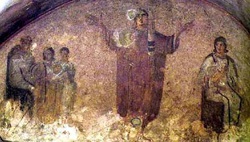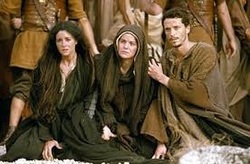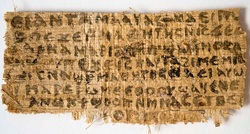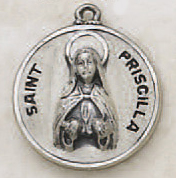|
|
 Once upon a time, women danced at the center of the gospel story, back when it was wild and free back when the stories of Jesus burned in the hearts and minds of those gathered in his name, long before the conversation shifted towards order and structure and assembly. We read across the shadows, the women of the early Jesus Movement, women who were of his own family and women whom he had healed and women who served him, like Joanna, wife of Herod’s steward and Susannah, who supported Jesus and his followers financially. We hear whispers of their lives, catch glimpses of their gifts and graces, see their forms bent and broken in grief at the foot of the cross, hands raised in victory at the empty tomb. It was natural then, that Paul turned to women to aid in his gospel mission, the man known as the Apostle to the Gentiles truthfully went first to the community of Jews in most cities and partnered with women to establish gatherings of the baptized in homes across the Roman Empire. It was Lydia, the wealthy business woman who sold purple garments who was the first convert in Europe and the answer to Paul’s supernatural Macedonian call. He baptized her and all of her household by the river in Philippi and she and other women such as Euodia and Syntyche lead the church in the region. It is the church at Philippi who helps to underwrite Paul’s future missions and whom Paul calls his “joy and crown.” Polycarp records for history that the church at Philippi is the most steadfast of all Paul’s churches, still standing strong into the 2nd century. It is compelling then, when Paul addresses his letter to Philippi in the 50’s AD to the επισκοπος, the bishops or overseers, that he is referring to Lydia and to the women who he will name in his letter who were likely leaders of house churches charged then with watching over the fledgling congregations that made up the Philippian church. After all, Lydia had been there since the beginning, had hosted Paul and likely welcomed friends into her home who received the gospel and became followers such that the church at Philippi was born. The evidence is even more compelling when we consider Prisca who together with her husband is Paul’s co-laborer in Christ. Meeting Paul in Corinth, Prisca and Aquilla are then sent by Paul to represent him and begin the work in Ephesus prior to his arrival and later seemingly go to Rome to do the same thing. In the letter to Romans Paul thanks Prisca and Aquilla for “risking their necks for my sake” and says the whole Gentile church is grateful to them. Later fragments confirm their return to Ephesus. In Romans Paul also names Junia and refers to her as his fellow prisoner and relative who is prominent among the αποστολοις writing that she and Andronicus were in Christ before him. These whispers haunt us and we want to know more, want to peel back the pages of history and hear the stories of our mothers. We dust off the ancient witness of 4th century Epiphanius, Bishop of Salmais and we read his own log, his record of the bishops who follow in the lineage of Paul. We scan the Greek, our eyes squint and we stare with wonder at two names scribbled out in the parchment, ΠΡΙΣΚΑΣ Bishop of Kolophon (outskirts of Ephesus), ΙΟΥΝΙΑΝ Bishop of Apamea, Syria (the Antiochene Episcopacy on the Orontes). Their names recorded here in male form, of course, by the 4th century no consideration is given to female leadership, no one is trying to hear what once was, so as Epiphanius wrote, as he recorded for posterity anyone who had served as bishop he recorded them as male. Only, these two names are shared by women, prominent women in the Pauline circle. Prisca and Junia are women whom Paul had entrusted with the gospel and with the leadership of the church, women who are named in the canon, women who were flesh and blood, who lived and breathed for Jesus and his church. And so we wonder, were we bishops… Photo: 2nd century mural from Greek Chapel in Priscilla's Catacombs; Rome, Italy For more information on Epiphanius' Indeces Apostolorum find my research at Academia.edu
4 Comments
 They were with him, weeping, lost and ruined at the foot of the cross, and they rose early a few days later to tend his bruised and beaten body at the tomb. His mother Mary through whom the Savior had come into the world and Mary of Migdol who became the first herald of the good news. It seems clear that in the incarnation and in Gospel proclamation, the hope of Christ, by God’s design and Spirit’s power was first made known through feminine vessels. Likewise, no one can argue Paul’s revolutionary claim in Galatians for the equality of male and female, Jew and Greek, slave and free. It is clear that Paul relied heavily upon female benefactors and Roman dominas as the early church took root in homes across the empire. Paul lauds Prisca and Junia, Phoebe and several others throughout his letters thanking them for their service to the Gospel. And then, we turn the page. Most who study the New Testament are more than jolted by the shift between the presence and prominence of women in the Jesus Movement and in Pauline circle to the restrictions of what we have come to call the Pastoral letters, specifically, I Timothy and Titus. Though these letters are attributed to Paul, students of ancient literature know well that the letter to I Timothy reads more like Ignatius than Paul, with its distinguished Greek, some 60 words never used in Paul’s letters, and concern for liturgical order and structure of hierarchy. We wonder where have our mothers gone, why have their stories been erased, why are they told to keep silent when it seems their voices were so necessary in the beginning. It is as if in the 2nd generation of the church, the leaders wanted to correct some of the dynamics introduced by Jesus and Paul, namely the elevation of women. If context is key, then I Timothy intended for the struggling leader of the church at Ephesus is of great import. Ephesus is a city teaming with female power as it is the home of the world famous Artemesion and the cult of Artemis, the female goddess of fertility and abundance. In this cult, the female goddess is served by female priestesses who braid and adorn themselves with golden jewelry. What’s more, ancient fragments tell us that Prisca and Aquilla return to the city and continue to lead the church in the area after their time in Rome. While a 4th century witness indicates that Priscas was Bishop of Kolophon just outside the city. Ephesus is also the city where John and Mary move onto after the resurrection and reside for some time. By the late 1st century into the 2nd, veneration of Mary, the mother of Jesus has already taken root. If we take all of this into consideration, it is not hard to read I Timothy then as a push back to feminine power, to understand that for some early church leaders it was all a bit too much so that our roles were reduced, redefined and relegated to silence and childbearing such that the firey women of the Gospel are asked to conform to the norms of respectable Roman wives, to be seen, obedient, discreet and not heard. This is how the silencing of our voices began. For more information, access my research at Academia.edu Photo: "Holy Women" St. Apollinare, Nuovo, Ravenna  If you think about it, the week we now call Holy takes us through the full expression of human emotion. The week begins with cheers and adulation, rings in with palm branches and children’s songs then moves to betrayal and abandonment to injustice and suffering and finally towards hope. What we have in the span of one week then, on the liturgical calendar, is an invitation into the darkness. For some of us we are relieved to finally have a season when our questions are valid, when our doubt makes sense, when our grief finds a home and we are not ostracized at our reluctance to celebrate the goodness of God in pithy unweighed theological statements like bumper sticker faith. For those of us who struggle in life lived with happy, clappy resurrection folk, who need a home for our lament, the cross allows us the space to ask, “Where are you God?” In fact, that’s exactly what Jesus asked, suffering as he was that day, life ebbing away on the rock of Golgotha. It is to Jesus I cling. It is to the story of the one who willingly suffered and died that I am compelled. It is to the one who prayed, “Father, take this cup from me,” who opened his eyes to find the cup still there and who drank deeply that I am drawn. If the truth be told, I am not sure I have reconciled to the God that allowed such agony to occur to his own son, to God’s own self, to lowly broken creatures like me, just trying to do our best in this world; why does such pain need to be known. This year as I walk through the Lenten season and into Holy Week, I am clinging to Jesus like Mary did, hoping, trusting, believing he will make some good out of all the pain. I need her strength, I need her courage, I need her understanding of suffering redemptive. As I walk through the darkness I am aware that this year it is not a mere liturgical season but the reality of my own life as not many weeks ago I stood over my own precious child—a nephew—gone too soon from us for reasons that are senseless and tragic. Like Mary, I anointed him with my tears, and I stayed with him until the end and I gave him back to God. It is in these moments of unspeakable agony when we, like Jesus, wonder where God can be found. We wonder how it is that we will make it through, and once more it is Jesus from the cross, thinking of Mary, and perhaps all of us who shows us the way. “When Jesus saw his mother and the disciple whom he loved standing beside her, he said to his mother, ‘Woman, here is your son.’ Then he said to the disciple, ‘Here is your mother.’ And from that hour the disciple took her into his own home” (John 19.26 ,27). Jesus knew his mother and his friends, he knew that we would have to go on, he knew that life is hard and tragedies happen and the world is blood soaked and broken. Jesus knew for those he loved life would continue, the sun would rise, the water would need to be drawn, the families would need to be fed, the laundry would pile up on the floor. Jesus knew what it was to suffer, to face the darkness and to feel as though God had abandoned you. He knew what it was to believe God could not hear your cries, had left you in your pain and Jesus knew, in those moments wrought with grief and loss, confusion and fear God could be found in the arms of someone who loves you, wrapped around you, bearing you up. In our sorrow, as we weep, as we struggle to find legs to stand, to remember to pay the phone bill and make grocery lists, as we remind ourselves to breathe in and out, we hold the hand of the one whom Jesus gave us, we lean in and we bear down and we remember in our loss we are connected, we are bound to Jesus and to each other, and in our bond God is found. Jesus showed us from the cross, this is how we make it through.  So there has been a lot of talk this week about the now published report from Harvard regarding an ancient papyrus first revealed by Dr. Karen King in 2012. The fragment contains dialogue attributed to Jesus which reads, “Jesus said to them, ‘My wife…” and later “she will be my disciple.” Thus, the firestorm that began with the introduction of this fragment a few years ago has promptly been reinvigorated as scientists are now able to carbon date the ink of the papyrus as consistent with other similar fragments dating from 400 BCE to 700 CE. For scholars, this means that we move the papyrus from the late forgery column to consideration as an authentic ancient artifact. Before all of Christendom is struck with cardiac arrest and turns to the streets with picket signs or pulls sponsorship of some organization or the other over evidence that Jesus may have been married and continued affirmation, in addition to the canon, that Jesus had female disciples; I’d like for us to take a collective breath and weigh out what all of this means. Seriously, breathe in, breathe out, take my hand and let’s talk through this. On the canon... First, we must admit that the evidence we rely upon most heavily for the details of Jesus’ life lie in the canonical gospels. If we understand the gospels as theological documents containing stories written about Jesus, at the earliest in the case of Mark, some thirty years after his death and Matthew and Luke closer to fifty years later while John’s gospel is the fourth and final dated somewhere around 90 CE, then we understand it is likely that there are some things Jesus said and did that we do not have recorded. In fact, the canonical gospels share nothing about Jesus’ life as a child, save the Temple story in Luke, and focus on his public ministry in the Galilee and the culmination of his life in Jerusalem at the crucifixion and resurrection. For the canon to be authoritative for our lives, we need only affirm that we have what we need necessary unto salvation, that is to say, we are not forced to contend that within the canon we have all that was ever done or said regarding Jesus in the early centuries. If this is true, we need not be threatened by ancient evidence that emerges to tell us more about the earthly life of God incarnate. On marriage… The truth is, for Jesus to have been a thirty year old Jewish man living in the first century who was unmarried would have been a cultural anomaly. However, this would not be the only thing Jesus did that was culturally askew; he also ate with sinners, talked with prostitutes, touched dead people causing them to be raised, and he said, “Blessed are the poor.” Thus, the contextual argument alone is not enough to conclude Jesus’ marital status. It seems the bigger question is, what does it mean for Christendom if Jesus was married? What does it change about Jesus’ role in God’s salvific plan? Does Jesus’ marital status call into question the Catholic Church’s rationale for the celibate religious life? Perhaps but we don’t see issues of celibacy for priests addressed until the Council of Nicea in the 4th century which says a priest cannot be married after ordination. For Protestants, who allow clergy to marry, what are the concerns? I wonder if the anxiety and outrage over the “Jesus’ Wife” papyrus says more about us than it does about Jesus. It seems like this debate asks what’s true; what’s true about Jesus, sure, but also, what is true about Jesus’ 21st century followers. Are we afraid to admit, there might be things about Jesus that we don’t know? Are we uncomfortable with a wild and free God who might have stepped outside the boundaries of what we’ve come to accept? Do we wring our hands at the notion of new revelations and more to learn about Jesus, the man who walked the sands Palestine, whose sandals slapped the Roman road under the burning sun? Do we have room in our hearts, space in our minds to explore possibilities, to open to what God might want to show us in this millennia, are we willing to accept Jesus as he is, not as we want him to be? While attending the Festival of Faith and Writing conference this week, I heard Rachel Held Evans say this to students at Calvin College in a chapel service. “I don’t think God wanted Scripture to be easy, otherwise we wouldn’t need to talk to God and we wouldn’t need to talk to each other.” Maybe this is why new scholarship on ancient papypri helps us along. Maybe it’s good for us to scratch our heads, dig deep and consider new ways of understanding the life of Jesus. Maybe this reminds us we need to talk to God and we need to talk to each other.  The season of Lent, the liturgy of Holy Week allows us our doubts, gives us space for lament, helps us put words to what we do not understand. Every once in a while, artists create something real and it strikes our hearts because it is true. The Garden series by the Liturgists has been this for me. Featuring Rachel Held Evans, Rob Bell, Amena Brown, and Gungor. Do your weary, wandering soul a favor and listen.  This is NOT an April Fool’s joke, rather a serious conversation I had with my New Testament students yesterday. I was surprised to learn that most had never pondered the notion of female authorship for the unpenned book of Hebrews that is neither written by Paul nor meant for the Hebrews. Instead, what we have in Hebrews is homily like material presented in such a way that Hebrew narrative is offered up in the tradition of Greek philosophy such that our best guess is we have a Hellenized author who was also part of the Pauline circle writing somewhere around 100 C.E. Students were assigned Ruth Hoppin’s article “The Epistle to the Hebrews is Prisca’s Letter” and I draw from her here as well as my own research across the years consulting fragments, archaeological evidence, and epigraphy to reconstruct a portrait of Prisca, the early church holy woman. The individual who wrote this work was educated, literate and close to Paul, as we study what can be known of her, Prisca fits all the above requisites. Mentioned six times in the New Testament canon, Paul describes Prisca and her husband Aquilla as persons who “work with me in Christ Jesus, who risked their necks for my sake, to whom not only I but the whole Gentile church gives thanks” (Rom.16.3,4). Because of their status in the canon, we know they are close companions and co-laborers in the Gospel with Paul. Scholars have noted that of these six instances, in four of them, Prisca’s name is listed first which seems to indicate her prominence in the work according to Paul. Because of archaeological evidence, we are able to discern a highly probable link between Prisca and the wealthy patrician family the Acilli Glabriones of ancient Rome. If she is a daughter of this famous house, then it stands to reason she would have been both literate and educated and well versed in philosophy. It is also possible that she fell in love with a Jewish Barbarian slave or freedman from her house who took on the family name, Acilli which morphed into Aquilla, that she later left Rome with him during the Claudian exile and together they encountered Paul in Corinth (Acts 18.2-3). As we read through Hebrews, we are aware of Greek, even Platonic undertones even as the author is working to convey the story of Israel. The first four verses of the epistle read as from an ancient hymn drawn from early liturgical practices that pre-date Paul’s own letters. While much has been written about possible authorship, some have wondered if it’s original author was Apollos; I want to ask, maybe the author of Hebrews was our girl, the one who took Apollos aside and taught him the ways of Jesus (Acts 18. 26-27). Of course, we can not come to any definitive solution here, time and space and sometimes agenda have prevented us from certainty. But if we know Prisca was an early Pauline circle leader, if its likely that she hailed from the Acillia Glabriones and was educated and nurtured in both Philosophy and the Paul’s Gospel of Jesus then is it too far to ponder her possible role as author? May God help us hear the voices of our mothers, chosen and called and vibrant in the texts we hold as sacred. |
Subscribe Today for Free GiftBLOG
Archives
June 2019
Categories
All
|

 RSS Feed
RSS Feed